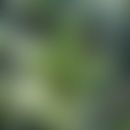Synonym(s)
DefinitionThis section has been translated automatically.
Ivy, an evergreen climbing plant up to 20 m high, is native to Europe. It grows and clings to trees, shrubs or walls by means of its adhesive roots.
The leaf dimorphism is special: all leaves are evergreen. The sterile twigs bear dark green, three- to five-angled lobed leaves with conspicuous veins, while the fertile, fruit-bearing twigs are shiny leathery, light to dark green, with entire margins and pointed tips. The brown flowers are less conspicuous and are arranged in spherical semi-umbrellas like clusters. Flowering time is September/October. The blue-black berries ripen a year later. Caution: Berries can cause symptoms of poisoning in children!
The dried leaves harvested in spring (ivy leaves - Hederae folium) are used phytotherapeutically, although the leaves harvested in summer are now also permitted.
The drug is imported from Eastern European countries.
OccurrenceThis section has been translated automatically.
You might also be interested in
Field of application/useThis section has been translated automatically.
Naturopathic use: Ivy leaf extracts have expectorant, anti-oedematous, antispasmodic and vasodilatory effects. Based on a randomized, double-blind, placebo-controlled study, the guideline of the German Society for Pneumology and Respiratory Medicine (DGP) strongly recommends ivy extract (Prospan®).
Hedera helix is the parent plant of Hedera folium, the ivy leaves. Monographsfrom Commission E, ESCOP and HMPC are available for Hederae folium.
Due to its antibacterial and fungicidal properties, ivy extracts can also be found in medicinal ointments, shampoos and tinctures as well as in natural cosmetics. Used in folk medicine for whooping cough, bronchitis and eczema. Frequently used as a rubefacient (skin irritant).
Cosmetic use: Hedera helix is used in cosmetics as an aqueous or alcoholic extract of ivy leaves.
Undesirable effectsThis section has been translated automatically.
All parts of the plant contain saponins of the triterpene type (hederin, hedera saponin B and C etc). The main allergen of common ivy is falcarinol (polyins). Sensitizing potency: Medium. Frequency of sensitization: Occasional.
ClinicThis section has been translated automatically.
In individual cases allergic contact dermatitis.
Note! Falcarinol is contained in other plant species of the Araliaceae family, e.g. Scheflera species such as ginseng or carrot or celery root.
The reactivity exists towards falcarinol; therefore no real cross-reactions are to be assumed. Ivy extract is primarily irritant. The majority of cases of dermatitis are irritant contact dermatitis.
Trade namesThis section has been translated automatically.
Prospan® Cough Syrup, Prospan® Cough Liquid, Prospan® Cough Suppositories
Note(s)This section has been translated automatically.
Hedera helix is the parent plant of Hedera folium, the ivy leaves. There are monographs for Hederae folium from Commission E, ESCOP and HMPC.
LiteratureThis section has been translated automatically.
- Kardos P et al (2019) Guideline of the German Society of Pneumology and Respiratory Medicine on the diagnosis and treatment of adult patients with cough. Pneumology 10
- https://www.awmf.org/uploads/tx_szleitlinien/020-003l_S2k_Diagnostik-Therapie-erwachsene-Patienten-mit-Husten_2019-12.pdf
- https://arzneipflanzenlexikon.info/efeu.php
- https://www.ema.europa.eu/en/documents/herbal-monograph/final-european-union-herbal-monograph-hedera-helix-l-folium-revision-2_en.pdf
Wenigmann M. (2017) Phytotherapy medicinal drugs, phytopharmaceuticals, application. Urban & Fischer, pp. 97-98




